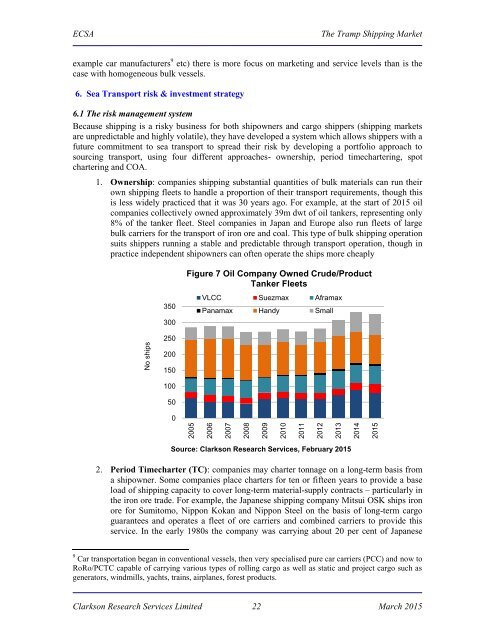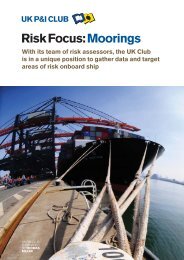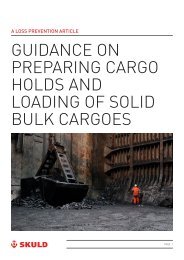You also want an ePaper? Increase the reach of your titles
YUMPU automatically turns print PDFs into web optimized ePapers that Google loves.
2005<br />
2006<br />
2007<br />
2008<br />
2009<br />
2010<br />
2011<br />
2012<br />
2013<br />
2014<br />
<strong>2015</strong><br />
No ships<br />
<strong>ECSA</strong><br />
<strong>The</strong> <strong>Tramp</strong> <strong>Shipping</strong> <strong><strong>Mar</strong>ket</strong><br />
example car manufacturers 9 etc) there is more focus on marketing and service levels than is the<br />
case with homogeneous bulk vessels.<br />
6. Sea Transport risk & investment strategy<br />
6.1 <strong>The</strong> risk management system<br />
Because shipping is a risky business for both shipowners and cargo shippers (shipping markets<br />
are unpredictable and highly volatile), they have developed a system which allows shippers with a<br />
future commitment to sea transport to spread their risk by developing a portfolio approach to<br />
sourcing transport, using four different approaches- ownership, period timechartering, spot<br />
chartering and COA.<br />
1. Ownership: companies shipping substantial quantities of bulk materials can run their<br />
own shipping fleets to handle a proportion of their transport requirements, though this<br />
is less widely practiced that it was 30 years ago. For example, at the start of <strong>2015</strong> oil<br />
companies collectively owned approximately 39m dwt of oil tankers, representing only<br />
8% of the tanker fleet. Steel companies in Japan and Europe also run fleets of large<br />
bulk carriers for the transport of iron ore and coal. This type of bulk shipping operation<br />
suits shippers running a stable and predictable through transport operation, though in<br />
practice independent shipowners can often operate the ships more cheaply<br />
350<br />
300<br />
Figure 7 Oil Company Owned Crude/Product<br />
Tanker Fleets<br />
VLCC Suezmax Aframax<br />
Panamax Handy Small<br />
250<br />
200<br />
150<br />
100<br />
50<br />
0<br />
Source: Clarkson Research Services, February <strong>2015</strong><br />
2. Period Timecharter (TC): companies may charter tonnage on a long-term basis from<br />
a shipowner. Some companies place charters for ten or fifteen years to provide a base<br />
load of shipping capacity to cover long-term material-supply contracts – particularly in<br />
the iron ore trade. For example, the Japanese shipping company Mitsui OSK ships iron<br />
ore for Sumitomo, Nippon Kokan and Nippon Steel on the basis of long-term cargo<br />
guarantees and operates a fleet of ore carriers and combined carriers to provide this<br />
service. In the early 1980s the company was carrying about 20 per cent of Japanese<br />
9 Car transportation began in conventional vessels, then very specialised pure car carriers (PCC) and now to<br />
RoRo/PCTC capable of carrying various types of rolling cargo as well as static and project cargo such as<br />
generators, windmills, yachts, trains, airplanes, forest products.<br />
Clarkson Research Services Limited 22 <strong>Mar</strong>ch <strong>2015</strong>




